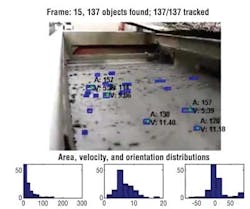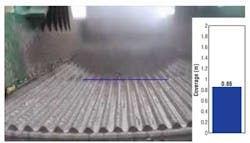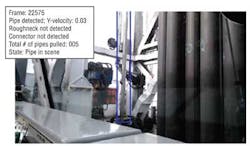Real-time data images enhance rig safety, efficiency-full
Peter Torrione, PhD
Kenneth D. Morton, Jr., PhD
Mark W. Hibbard
CoVar Applied Technologies, Inc.
Modern drilling involves scores of people and multiple inter-connecting activities. Obtaining real-time information about ongoing operations is of paramount importance for safe and efficient drilling. As a result, modern rigs often have thousands of sensors actively measuring numerous parameters related to vessel operation, in addition to information about the downhole drilling environment.
Despite the multitude of sensors on today's rigs, a significant portion of rig activities and sensing problems remain difficult to measure with classical instrumentation, and person-in-the-loop sensing is often used in place of automated sensing.
By applying automated, computer-based video interpretation, it is possible to achieve continuous, robust, and accurate assessment of many different phenomena through pre-existing video data without requiring a person-in-the-loop. Automated interpretation of video data is known as "computer vision," and recent advances in computer vision technologies have led to significantly improved performance across a range of video-based sensing tasks. Computer vision can be used to improve safety, reduce costs, and improve efficiency.
Shale shaker analysis
Accurate, real-time information about the cuttings and mud on the shale shaker can be invaluable. For example, a distinct change in the shape and size of cuttings can indicate an unexpected change in the subsurface lithology. Similarly, accurate localization of the mud-front on the shale shaker can help ensure that the shale shakers are operating efficiently. However, the location and operational environment of shakers makes classical system instrumentation difficult and expensive. Computer vision provides a robust and inexpensive way to automatically and constantly track the shaker, mud flow, and cuttings state.
Particle analysis
The image at lower left shows a frame of a shale shaker demonstration video enhanced with automated video processing to:
- Isolate individual particles on the shaker using object detection techniques
- Track the particles over time using a temporal-spatial-feature tracking algorithm
- Measure the particle sizes, shapes, and velocities using image morphology techniques. The resulting distributions of particle features (e.g., size, shape, velocity, eccentricities) form a statistical distribution (histograms below the image). These histograms can flag changes in these distributions, and bring that information immediately to the attention of the mud-logger or driller, significantly increasing drilling safety and efficiency, and helping provide better understanding of the lithology at the bottom of the well.
Mud front
One of the largest day-rate expenses on a rig is the cost of drilling mud, and mud can be easily wasted if it is allowed to flow from the shale shakers overboard. Proper setting of the flow rate and choice of screen size is complicated, since the ideal parameters change with various mud and well parameters. Measuring the location of the fluid front would enable automated shaker monitoring, but developing classical fluid-front monitoring instrumentation has been problematic. Since the fluid front can be identified visually, computer vision techniques can automate this processing. The above image shows an example frame of a demonstration video showing how the fluid front can be automatically identified in a video of the shale shakers. A camera ordinarily measures object positions in units of pixels, which need to be converted to real-world units (e.g., inches) in order to be useful for automated control. This example video shows how it is possible to use knowledge of the camera parameters and location to infer real-world coordinates (the fluid front location) from the raw camera data.
Pipe handling
Some real-world tasks are so commonly performed by people that it can be difficult to envision how automated sensing could help save time or money. Pipe tallying, for example, is typically accomplished by a human, manually recording the number and length of joints added to the drillstring. Failure to tally pipe correctly can result in incorrectly calculated bottomhole location and poorly sequenced lithologies. Recent proof-of-concept studies have examined the ability of computer vision techniques to count sections of pipes as they enter and exit the camera field of view, as well as to measure the pipe diameter, lengths, and orientations with respect to the camera. The image below shows an example illustrating a tool for detecting, counting, and estimating the size and position of pipes on a drillstring as they are pulled out of the hole. Current results indicate reliable pipe-tallying capability and the potential for accurate pipe length and diameter estimates using a single camera oriented toward the drillstring.
Personnel identification
New generation rigs commonly include pipe-handling and mechanized rig-floor equipment. For the time being, person-machine-interactions are controlled solely by the equipment operator, and increasing rig autonomous action represents a major safety concern. A safe, automated rig can only be achieved by tracking the locations of all people on the rig floor at all times.
Many wearable technologies exist for determining personnel location (e.g., RFID), and on-board protocols are designed to make sure personnel are not in harm's way. However, both of these approaches require personnel to comply with protocols and voluntary usage of additional hardware, some of which may fail. Research in the application of personnel tracking and localization (personnel video monitoring, or PVM) in various real-world scenarios is ongoing. This work has resulted in a prototype real-time system capable of accurate personnel location identification in a wide array of environments, against complicated backgrounds.
The PVM system leverages multiple camera feeds to simultaneously find the people in each frame (camera field of view). Then, using knowledge about the camera positions and orientations, each person's location can be triangulated in rig coordinates, building a real-world spatial map of each person and his or her location. As people enter and exit the scene (work area), they appear as "dots" on a two-dimensional map of the rig floor; the information in that map can then be automatically leveraged to inhibit automated equipment actions when people are in harm's way.
The PVM system can operate on a computer rendering of a rig floor to show people moving about a realistic rig floor, with realistic camera placements. This technology can be used to illustrate how computer vision technologies can be used to not only detect people, but also to accurately estimate their location on the rig, thereby providing information to operators about safe and unsafe activities, as well as potentially inhibiting automated actions (e.g., the moving pipe-stand).
Less rigorous personnel detection approaches often fail under complicated lighting, background and partial occlusion situations, and effort is required to ensure that the system is robust to these scenarios. The technologies described here leverage state-of-the-art computer vision person detection algorithms, and are robust to varying lighting and complicated backgrounds. Furthermore, leveraging multiple cameras simultaneously allows PVM to track people even when they are occluded in several camera views.
Passenger manifest generation
During an emergency evacuation situation, knowledge of personnel locations is required for efficient evacuation and deployment of rescue vehicles. Knowing who has boarded a lifeboat or raft versus who may still be on board the rig can save lives. It makes sense to leverage camera technologies to track and identify people as they enter muster areas (or lifeboats or rafts), and automatically generate passenger manifest/muster lists. In the case of an emergency, these manifests can be immediately and automatically sent ashore, with a listing of personnel, a photo of them boarding the lifeboat or raft and their company ID photo for comparison, for further analysis.
The technology also can be used to identify people as they enter an enclosed space. As each person enters the scene, face detection algorithms are applied to isolate the subject's face, and then machine learning and pattern recognition techniques are used to match the face to a pre-existing database of faces (e.g., from ID photos, or photographs taken when people arrive on the rig). This information can then be used to generate a passenger manifest.
Whole rig analysis
At a bigger picture level, many on-board sensing problems are complicated by the nature of the dozens of interacting activities that go on during drilling. For example, pit-volume sensors are relatively mature and robust, and unexpected changes in pit-volume are a good indication of unexpected influx. However, automated influx alarms based solely on data from a pit-volume sensor typically have low detection probabilities and high false alarm rates, causing these automated alerts to be ignored or turned off. The cause is often the lack of big-picture awareness in any one sensing application. In the pit volume example, many different rig activities can affect the pit-volume, which significantly complicates timely influx detection. Understanding the interaction of the different factors that can affect multiple sensors is, therefore, fundamental to robust automated processing.
In addition to solving small-scale sensing problems, computer vision technologies can be used to help solve large-scale rig problems. In the general case, computer vision can identify behaviors and situations that have an effect on any sensing application, and that additional information can be used to improve automated data interpretation and alarm generation.
Conclusions
Collecting and automatically analyzing data is an important part of modern safe and efficient drilling. Computer vision technologies currently under development at CoVar Applied Technologies can analyze video feeds to enable low-cost, effective measurement of a number of personnel-based operational and safety factors that are difficult or expensive to analyze with classical instrumentation.
However, the potential applicability of computer vision on the rig is much larger than these specific technology applications. In the future, computer vision could be leveraged to provide a whole-rig analysis of operations and activities which can significantly simplify processing data from currently existing data sources.
The authors
Dr. Peter Torrione is a co-founder and CTO of CoVar Applied Technologies. His expertise is in the application of machine learning and computer vision techniques to solve real-world problems. Prior to joining CoVar, Torrione was the President of New Folder Consulting, L.L.C., and an Assistant Research Professor at Duke University, where he received his PhD in Electrical and Computer Engineering.
Dr. Kenneth D. Morton, Jr., is a co-founder and Chief Scientist of CoVar Applied Technologies. His research is focused on the use of Bayesian statistical methods to improve performance for signal processing and machine learning problems in a variety of real-time and real-world application areas. Morton received the BS degree in electrical and computer engineering from the University of Pittsburgh and MS and PhD degrees in electrical and computer engineering from Duke University.
Mark Hibbard is President and CEO of CoVar Applied Technologies, Inc. Prior to founding CoVar, Mark was Executive Vice President and Chief Technology Officer of NIITEK, Inc., a company dedicated to saving warfighter lives through the development and manufacture of its proprietary ground penetrating radar sensor systems. Hibbard has a Bachelor of Science in Physics from the College of William and Mary and a Master of Business Administration from the Robert H. Smith School of Business, University of Maryland.
Privacy concerns
There has historically been significant push-back from drilling rig crews against the application of certain video technologies on rigs. Crew concerns are typically related to the sense that video technologies represent an imposing "big brother" monitoring system. In fact, to the degree video monitoring is used to micro-manage and critique, it can be an unwelcome intrusion into an already stressful and difficult environment.
Most of the application areas discussed here (e.g., shale shaker, pipe handling) are relatively distinct from classic big-brother-type monitoring, and people should rarely be visible in these video streams. However, other technologies (e.g., PVM, muster-point) can be easily misconstrued as an automated, ever-present behavior monitors. For these application areas, it is important to draw a firm and clear line between what is monitored (person locations in PVM, and times and identities of people entering evacuation systems in muster-point analysis), and what is not monitored (person identities and activities, lengths of breaks, etc.).
The goal of this ongoing video technology development is to increase safety of personnel on the rig, whether by preventing man-machine collisions or by ensuring that everyone has evacuated during an emergency situation successfully. Proper communication of the goals (and built-in limitations) of these technologies is therefore required to get crew buy-in and to build the next generation of safer rig systems.



